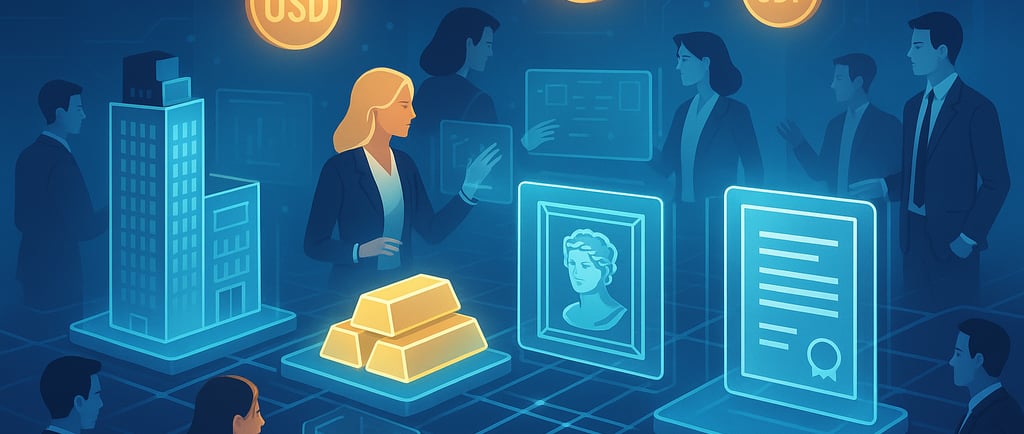Tokenization and the New Economy: How It Works in Practice and Who’s Profiting
Discover how real-world asset tokenization works, who’s profiting, and why stablecoins and blockchain are powering a new global economy. A must-read guide.
GUIDES
8/13/20253 min read


The financial world is undergoing a silent revolution: the rise of asset tokenization. As blockchain technology matures and regulatory frameworks evolve, a new economy is emerging—one where virtually any asset can be represented, traded, and managed on-chain.
In this guide, we explore how tokenization works in practice, who it's for, and how individuals and institutions are already profiting from it.
What Is Real-World Asset (RWA) Tokenization?
Tokenization refers to the process of converting the ownership rights of a real-world asset into a digital token recorded on a blockchain. These assets can include physical property (like real estate), financial instruments (like bonds), or even intangible assets (like intellectual property).
Unlike simply digitizing documents, tokenization involves the creation of programmable, transferable units of ownership secured by cryptographic technology. These tokens are transparent, divisible, and globally accessible.
How Tokenization Works in Practice
The tokenization process generally involves the following steps:
Asset Identification and Custody: The asset to be tokenized is identified and held under legal custody.
Token Issuance: A digital representation of the asset is created on a blockchain (Ethereum, Polygon, or specialized chains like Polymesh).
Smart Contracts: Rules governing the token's behavior (e.g., transferability, dividends) are embedded via smart contracts.
Liquidity and Exchange: These tokens can be traded peer-to-peer or on platforms that support tokenized assets, often using stablecoins for settlement.
This process ensures transparency, immutability, and automation—features that reduce friction and enhance trust across the ecosystem.
Who Can Benefit from Tokenization?
Tokenization is not just for large corporations. It offers tangible benefits across multiple sectors:
Small and Medium Enterprises (SMEs) can tokenize assets like receivables, real estate, or inventory to access funding without traditional intermediaries.
Institutional Players like asset managers, banks, and governments use tokenization to streamline operations, increase asset liquidity, and open new markets.
Retail Investors gain access to previously illiquid or high-value assets through fractional ownership and lower entry costs.
Who’s Already Profiting from Tokenization?
According to various industry reports, financial institutions and tech-forward companies are already capitalizing on tokenization:
Asset Managers like Franklin Templeton have launched tokenized treasury funds.
Global Banks and Financial Institutions are piloting tokenized securities and digital bonds in collaboration with blockchain platforms.
Blockchain Platforms like Brickken and Tokeny enable businesses to tokenize and manage assets with built-in compliance features.
Individual Investors are earning returns through tokenized real estate platforms and DeFi-integrated RWA pools.
These examples illustrate a growing trend: real value creation driven by blockchain-based infrastructure.
Impact on Traditional Markets
Tokenization brings several advantages that disrupt traditional systems:
Lower Costs: By automating trust and removing intermediaries, tokenization reduces fees and administrative burdens.
Faster Settlement: Transactions settle in minutes, not days.
Greater Liquidity: Assets that were previously illiquid (e.g., private equity, fine art) become tradable.
Financial Inclusion: Enables global access to investment opportunities.
Regulatory Complexity: While promising, tokenization faces legal and compliance hurdles that vary by region.
According to various blockchain think tanks and financial regulators, standardization and regulatory clarity will be key to mainstream adoption.
Stablecoins: The Foundation of the Tokenized Economy
Stablecoins play a central role in tokenized ecosystems by providing price stability and on-chain liquidity. They serve as the primary medium for trading tokenized assets, enabling seamless settlements.
New use cases are emerging:
Payments and Remittances
Collateral for Lending Platforms
On-Ramps for Traditional Institutions
Stablecoins pegged to national currencies (e.g., USD, EUR, GBP) are increasingly being used in domestic tokenization strategies, particularly in Europe and North America.
How to Participate in the Tokenized Economy
Whether you're an investor or entrepreneur, getting involved starts with education and strategy:
Retail Investors can explore regulated platforms that offer tokenized assets like real estate or debt instruments.
Businesses can consult with tokenization service providers to structure compliant offerings.
Precautions: Ensure proper due diligence, regulatory alignment, and smart contract audits before engaging.
The Tokenized Economy Is Already Here
Tokenization is more than a trend; it's the infrastructure for a more open, efficient, and inclusive financial system. From stablecoins to real-world asset platforms, the building blocks of the token economy are already in place.
Whether you’re looking to invest, build, or innovate, the time to understand and engage with tokenization is now.
At The Blockchain In, we are committed to helping professionals and businesses navigate this transformative shift. Staying informed, educated, and strategically positioned is key to unlocking the full potential of the tokenized economy. Follow us to stay ahead of the curve.
The Blockchain In
Guides, news, analysis, and investment tips on cryptocurrencies and blockchain.
CONTACT and partnership
Let us know about your experience here
hello@theblockchainin.com
© 2025. All rights reserved. Privacy Policy | Terms and Conditions | Cookie Policy | Disclaimer
about us
About
Contact